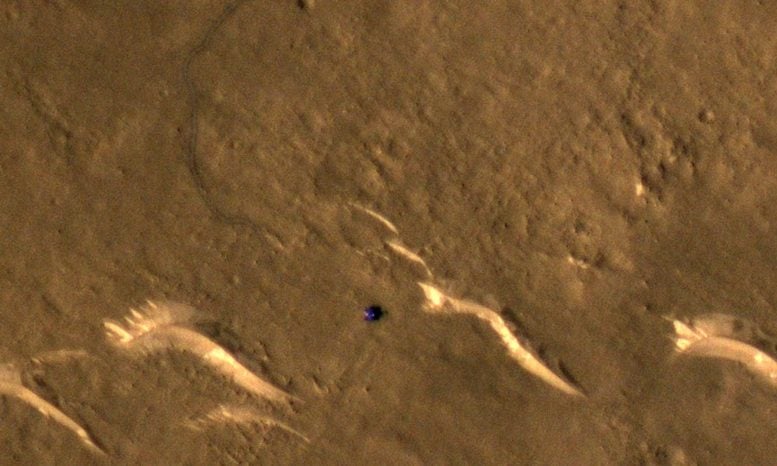Le dune di sabbia di molte forme e dimensioni sono comuni su Marte. In questo esempio, le dune sono quasi perfettamente circolari, il che è insolito. Credito immagine: NASA/JPL-Caltech/Università dell’Arizona
Sono comuni dune di sabbia di molte forme e dimensioni[{” attribute=””>Mars. In this example, the dunes are almost perfectly circular, which is unusual.
They are still slightly asymmetrical, with steep slip faces on the south ends. This indicates that sand generally moves to the south, but the winds may be variable.

Credit: NASA/JPL-Caltech/University of Arizona
This is part of a series of images (see above) to monitor how frost disappears in the late winter; this observation appears to be free of frost. A previous image (below) shows when the surface was covered by frost.

Circular sand dunes on Mars captured by the Credit: NASA/JPL-Caltech/University of Arizona
The map is projected here at a scale of 25 centimeters (9.8 inches) per pixel. (The original image scale is 30.3 centimeters [11.9 inches] per pixel [with 1 x 1 binning]; Le cose sono nell’ordine di 91 cm [35.8 inches] Via è risolto.) Nord in alto.

La mappa qui viene visualizzata su una scala di 25 cm (9,8 pollici) per pixel. (L’immagine originale misura 30,3 cm [11.9 inches] per pixel [with 1 x 1 binning]; Le cose sono nell’ordine di 91 cm [35.8 inches] Via è risolto.) Nord in alto. Credito immagine: NASA/JPL-Caltech/Università dell’Arizona
HiRISE è l’acronimo di High Resolution Imaging Scientific Experiment. È un sistema di telecamere a bordo del Mars Reconnaissance Orbiter, un veicolo spaziale in orbita attorno a Marte. HiRISE è la fotocamera più grande e potente mai inviata su un altro pianeta ed è progettata per acquisire immagini incredibilmente dettagliate della superficie di Marte. La risoluzione più elevata consente agli scienziati di studiare la geologia, la mineralogia e la topografia del pianeta in modo molto più dettagliato di quanto fosse possibile in precedenza.

Concetto artistico del Mars Reconnaissance Orbiter. Credito: JPL/NASA
Il Mars Reconnaissance Orbiter (MRO) è un veicolo spaziale lanciato da esso[{” attribute=””>NASA in 2005 to study Mars. The main goal of the MRO mission is to understand the geology, climate, and search for signs of water and potentially habitable environments on Mars. The spacecraft is equipped with a suite of scientific instruments, including the HiRISE camera, as well as radar, spectrometers, and other sensors. The MRO orbits Mars in a highly elliptical polar orbit, which allows it to image the planet’s surface and atmosphere, study its geology and mineralogy, and search for signs of water and other resources. The mission has been ongoing since its launch and has made numerous discoveries and advancements in our understanding of Mars.
The University of Arizona, in Tucson, operates HiRISE, which was built by Ball Aerospace & Technologies Corp., in Boulder, Colorado. NASA’s Jet Propulsion Laboratory, a division of Caltech in Pasadena, California, manages the Mars Reconnaissance Orbiter Project for NASA’s Science Mission Directorate, Washington.

“Fan della TV. Risolutore di problemi malvagi. Amante del cibo appassionato. Explorer. Specialista di Internet. Imprenditore dilettante. Fanatico dell’alcol.”




